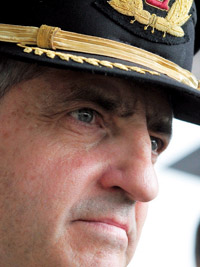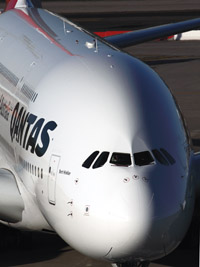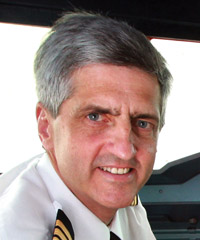News Feature
Don’t rely on automation
QF32 hero says training needs to be improved
November 1st 2012
On November 3, 2010, Qantas Airways’ A380 flight QF32 took off from Singapore bound for Sydney, en route from London, with 469 passengers and crew on board. Four minutes later, climbing over Indonesia, one of its giant engines exploded. The man credited with saving the aircraft and all on board, Capt. Richard Champion de CrespignyRead More »
 |
| 'Everyone thinks we had 60 (faults). We had 100 in the air and 20 on the ground. It took an hour to find out what was wrong with the aircraft' |
| Capt. Richard de Crespigny |
Qantas Airways Capt. Richard Champion de Crespigny, who led his crew through one of the greatest mid-air dramas in recent history, is adamant. Anyone who suggests automation in today’s modern jets has made the pilot’s role easier is dead wrong.
“These aircraft are now so complex – four million parts and 250,000 parameters and sensors - that it is getting harder [to fly] because a pilot still has to recover the aircraft whether it’s stalling, inverted, on fire or spinning. Our job is still the same, but we are operating with a more complex aircraft and fewer pilots,” he said.
Compare the A380 with the Wright Flyer that launched powered flight, he suggested. “It’s 10,000 times heavier and a thousand times more complex, but it only has one more pilot. It hasn’t got any easier. If people designing training systems haven’t recognized this perhaps it should be changed,” he warned.
De Crespigny said ignorance is no excuse. “You’re there to fly the aeroplane. Non-knowledge or not fully understanding the aeroplane is not an excuse. When there is something wrong you can’t take your hands off and say we are all going to die,” he said.
“In a car, when something goes wrong, you can pull over to the side of the road and call a friend. You can’t do that in an aircraft.”
Many industry insiders still find it difficult to believe how Capt. de Crespigny and his four fellow pilots (two regular crew and two check captains), along with the assistance of the cabin crew, managed to keep the crippled aircraft in the air long enough to return to Singapore.
When the Rolls-Royce RB211 engine exploded it sent shrapnel slicing through the aircraft, severing vital wires and punching some 100 holes in the wings and fuselage. Fuel tanks were punctured in several places.
In the cockpit, threat and error warnings lit up the electronic monitoring system. Even after the plane landed the crisis was not over. An engine refused to stop and, with over-heated brakes, the plane sat for two hours with tonnes of fuel under its belly.
“We were in uncharted territory. I’m the pilot in command and I’m looking at the fuel panel and I don’t understand it. The checklists were leading us on a passage of discovery. It took an hour and they described everything that was wrong with the aircraft. It was exposing all the faults and prioritizing,” said Capt. de Crespigny.
 |
| Qantas Airways: the plight of the crippled A380 was one of the greatest mid-air dramas in recent history |
“Everyone thinks we had 60 (faults). I think we had 100 in the air and 20 on the ground.”
Today, Capt. de Crespigny will not criticize his tools: the A380 and its Rolls-Royce engines. It was a catastrophic failure of a turbine disc on one of the engines that threw them into the life or death situation.
He has been asked many times in the last two years to give talks on his QF32 experience. When he does, Capt. de Crespigny wears a Rolls-Royce tie. “I am absolutely supportive of Rolls-Royce. They have great engines. Once in 40 years and once in 200 million engine hours it’s a case of **** happening. What’s more we got the aircraft down,” he said.
The A380, he said, was flying well outside its certification, with 600 wires broken – a number he believes will rise when the final Australian Transportation Safety Board (ATSB) report is released – yet it performed incredibly well.
“Most aircraft with these turbine disc failures don’t come back. Even if they [get back] on the ground the aircraft are usually destroyed. This aircraft didn’t just survive, it flew beautifully and 469 people were returned home safely. It’s a testament to the Airbus design.”
De Crespigny is back on the Qantas flying roster piloting A380s, but there is no doubt his life has changed. He has written a book, QF32, which tells the story of the drama and about his life.
Today, he talks enthusiastically about the lessons learned and how pilot training can be improved. He continues to praise the crew, in the cockpit and the cabin, who worked as a team to get the plane home.
There has been a great deal of discussion about whether pilots need to slavishly follow checklists. De Crespigny and his crew didn’t.
“I am an empirical sceptic. Everything has to be based on reasoning, logic and statistics,” he said. “So we were sceptical of the checklists. Not to say we didn’t trust them. Some checklists we did straight away. Some we questioned.
“Some we refused to do, like transferring the fuel, because we simply didn’t know what the situation was with leaking fuel and which tanks were affected.”
De Crespigny is clear about the process that saved the day in November 2010. It was all about knowledge, training, experience and teamwork:
• Knowledge: “You have to know your aircraft and know about the job … study never stops for pilots. You never know it all. Never,” he said.
• Training: “I’m proud of what Qantas does for training. We do so much more than other airlines”.
• Experience: “For the pilot it means going to the bar and talking about these things, reading the crash journals and reading about all those accidents. It’s doing things hard. When I go to the simulator, every landing I do is in 40 knots of crosswind. It’s the hardest thing, but if I can do 40 knots of crosswind, which is the limit for the aeroplane, then anything after that is easy. It’s about deliberate practice. Do not accept mediocrity.”
• Teamwork: “Cockpit Resource Management (CRM) and the theories of teamwork, human factors, ego, decision-making and culture. The aircraft must have a leader.”
While he and his crew have received many plaudits and awards for their actions, there were also criticisms. The two main ones were: why didn’t he head straight back to Singapore instead of flying for more than hour before landing and why did he take two hours to evacuate the aircraft on the ground.
“Why didn’t we land straight away? We wouldn’t have known if the gear would come down. We wouldn’t have known if the aircraft was safe without a control check. We wouldn’t have known the approach speeds. We built ourselves a new aeroplane,” said Capt. de Crespigny.
“[The plane we] landed was completely different from the one we took off in. We built it up from the ground. We landed with a great aeroplane and we knew we could do it.”
He stayed in the air and did aircraft controllability checks – there is no published procedure for Airbus fly-by-wire aircraft – because he needed to know what leeway he had in controlling the aircraft in flight and particularly during the final approach.
As for evacuation: “There were three tonnes of fuel on the ground and engine number one wouldn’t shut down. You have to be very careful about evacuating. It was so dangerous around the aircraft.”
De Crespingy refers to a Virgin Atlantic A330 which evacuated passengers at London’s Gatwick airport earlier this year because of a smoke warning in the cargo bay.
Fifty five people were injured, including broken ribs and spinal and cranial injuries. There were 40 women with pantyhose fused to their skin, caused by the speed of descending escape slides.
“We were in a bigger aircraft. We had 469 people on board. We’re on the Kangaroo Route from London to Sydney. We have elderly people on board, babies and wheelchairs. The plane is three storeys high. There’s not only fuel, but 60,000 litres of (firefighting) foam on the ground.
“The passengers were safer in the controlled environment of the aircraft. We didn’t break a toenail.”
De Crespigny believes the valuable flying experience of older pilots is not being handed down to younger crew any more. “The reality is that people who join airlines now have never seen a fully developed stall or a spin. If they’ve never seen it they won’t recognize it and they certainly won’t know how to pull out,” he said.
If training is degraded situations will arise where inexperienced pilots don’t have the skill to handle it, added Capt. de Crespigny. “When people say the aircraft is fully automated and there is less to do on the flight deck, I disagree,” he said.
“In my book, particularly on these complex aircraft, you do not take them for granted. On QF32 we had a highly experienced crew, we had fantastic systems knowledge and we were on top of it. We never panicked.
“We never declared a Mayday because we never thought we were going to die. During the whole procedure we always had enough system knowledge.
“So you cannot take the skills that have been developed in the last 110 years for granted. You can’t take the skills in the Qantas safety management systems [developed] over 91 years for granted.
“The young pilots now go to their hotel rooms and play computer games. They don’t socialize as much. They are missing out on this stuff.”
Airbus has recently announced that when the A350 is launched, in the first three or four simulator sessions for pilots a lot of the automation will be disabled to enable them to fly under non-automated conditions.
De Crespigny believes changes to pilot training shouldn’t be done at local level. “This is a change that should be recognized by ICAO (International Civil Aviation Organization) to raise the standards for everyone,” he said.
He constantly refers to the recovery of QF32 as a team effort. “I am just so proud and privileged to have worked with such excellent cockpit and cabin crews. The cabin crew were calm and they kept the passengers calm. Everything was done slowly and methodically. We never panicked,” said Capt. de Crespigny.
Richard de Crespigny’s book QF32, is published by Pan Macmillan Australia as a hardback edition only in Australasia. It is also available as an e-book. The hardback can be ordered at qf32.aero
Preparing for the ‘Armstrong Spiral’
 |
| 'I wanted to get into a position to do an Armstrong Spiral if we lost all the engines' |
| Capt. Richard de Crespigny |
At one point during his mid-air crisis, Captain Richard de Crespigny was prepared to turn his big A380 into a virtual space shuttle.
Faced with the possibility of losing all four engines, his mind moved towards plans to perform what is known as an ‘Armstrong Spiral’. Neil Armstrong, the first man to walk on the moon in 1969, was instrumental in designing the landing approach for the space shuttle.
As it re-enters the earth’s atmosphere the shuttle has no engines and little lift from its stubby wings, meaning it has to use a complex flight path, twisting and turning to bleed off speed, as it glides into landing.
As the crisis over Southeast Asia developed, de Crespigny wanted to climb into a position to be able to glide to a landing if necessary. “When I went for that climb the reasons in my mind were clear. I wanted to get into a position to do an Armstrong Spiral if we lost all the engines. I didn’t understand the fuel system and I didn’t know how long the engines would run for. I had no idea,” he said.
The Australian pilot was no stranger to the Armstrong Spiral. He had researched it in 2007 and even suggested to Airbus it should be included in the flight management system of future aircraft “to put into the display screens and into the oral messages for the pilots to give them guidance down to touchdown”.
De Crespigny knew Armstrong, who died in August aged 82, and was in regular contact with him. He told him after the drama that he had been preparing for an Armstrong Spiral if he lost all four engines on the A380.
De Crespigny said he wanted to get as close as possible to Singapore with the chance to do a spiral descent to land.
“It was so sad to see Neil go. He had so much more to offer. The last communication I had with him was on August 2. He went into hospital for his operation on August 8. [Armstrong died on August 25].”